Winter pants trousers Inverted Splinter 1943-45 RARE PATTERN
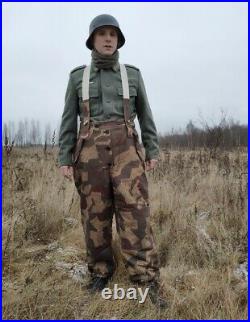
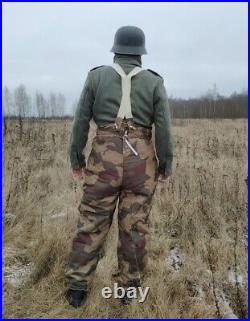
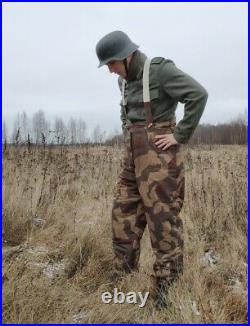

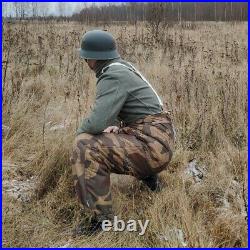
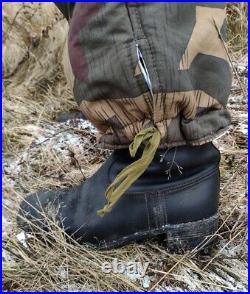



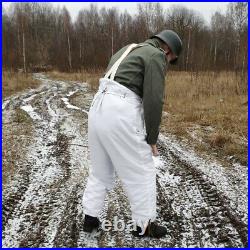
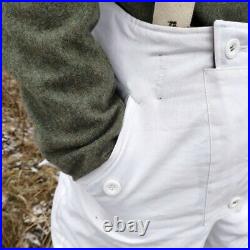
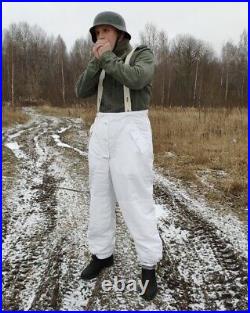
Neither pants nor helmet, belt are included (despite the fact that they are shown in the photo). We offer matching jackets in another listing. The pants are sewn from natural fabric with linen weaving (cotton duck, such as a tent). Such fabric protects from wind and water the best. Unfortunately, the fabric is not completely waterproof because it is not synthetic.
Original winter sets also got wet (especially towards the end of the war, when there were a lot of viscose in the composition). Below is a video about fabric printed exclusively for our shop in October 2019. The camouflage pattern is carefully copied. Suspenders of the pants were usually made from a braid of a harsh (off-white) color. The ends with buttoned loops are often reinforced with camouflage or white fabric.
German winter pants have one design flaw: the attachment of suspenders. When you squat fast, the load on the buttons that hold the suspenders on the back is so big that they come off. Only at the very end of the war did the Heer try to solve this problem by fixing suspenders to wooden bosses that were fastened to the pants through a tie (due to the large area of the mount, it withstood heavy loads). The SS tried to solve this issue when creating a camouflage winter uniform. They made straps with buttons for fixing standard elastic suspenders on them, like it's on M43 field trousers. However, this model did not go into series and until the very end of the war the problem remained. Before using pants for the first time, we recommend to stitch the buttons on the back through (one to another). There are reinforcements on the knees of the pants (extra layer of fabric). Typically, these pieces were cut across (not along the fabric), and the camouflage pattern there always goes horizontally.The front closure has a wind-flap without insulation. These features appeared together with camouflage models of pants (they are rarely found on plain colour, mouse-gray ones). These features appeared no earlier than the winter of 1943/44. Moreover, these features of tailoring are not boundedd to the color of the jacket, but to the time of its manufacture. For example, the original winter suits in camouflage Oak Spring (green shades of spots) were sewn both to the early and late patterns.
How to choose the size? Size II (medium) is worn on a person who usually wears Russian size 52 or L, XL.
Height 180 cm, chest 100 cm, body circumference under the lower rib 92 cm, belly circumference 98 cm. The key size for the pants is the circumference under the rib! If this body part fits into the pants, then the belly will definitely fit. The size of the jacket fits the size of the pants, that is, the jacket and pants must be bought in the same size. The standart height for the jackets and pants is 182 cm.
This affects the length of the sleeves for jackets and the length of the legs for pants. German winter jackets were of three sizes: small, medium and large; we did the same. Canadian soldiers in Merksem, Belgium (near Antwerp), seizing the unifroms warehouses of the factory Reitz The terrain is flat, rugged by rivers, the weather is windy and cold: Canadians are insulated as they can. Pay attention to the ratio of length and width of German winter jackets.
You can choose the size without trying. You will need a flexible meter or at least a rope. Measure a similar winter jacket that suits you. Designations: Flat top width of pants horizontally on the upper cut; this place is located directly under the ribs (not where jeans are worn, because the waist of the German uniform is higher); this is the pants' bottleneck: the waist and hips of the pants will be wider.
Lenght along the leg outside seam. Depth from waist to the crutch, along the front. Winter pants are deep, like standard field pants. Waist maximum girth below the rib, but above the navel, where the Germans had a belt; the first measurement over the naked body (in brackets the same but over shirt + sweaters + tunic, as is customary to wear these pants). All measurements are in centimeters. Devide numbers to 2,54 to have inches. Measurements are correct only for this product. We have sizes I, II and III now (all sizes available). How to care for the product? The soldiers at the front did not have the opportunity to wash their jackets (especially in the washing machine).After the winter (or in the case of taking the unit to rest in the deep rear), they handed the winter uniform over, and the rear services cleaned, sorted and stored it. Therefore, washing the winter uniform in the washing machine is an extreme measure. To get started, you just need to wash the jacket with a sponge or a soft brush with soap or detergent for natural fabrics in those places where it is dirty (usually this is the neck and cuffs). You can wash off the detergent with a jet of water (shower in the bathroom, for example). The use of bleach (stain remover) is permissible only manually on the white side and on a dry jacket.
So you can return the whiteness to the cuffs and other dirty areas. However, if bleach seeps onto the camouflage side (for example, through a seam), white spots will forever remain. It is unacceptable to wash the entire jacket in bleach! Washing a jacket is the removal of contaminants from external surfaces; inside the jacket there is nothing to wash. If you decide to save time and wash in a machine, then select the delicate washing mode at a temperature of no higher than 40 degrees.
The jacket will not deteriorate, the color will not fade, however, the jacket will slightly lose its shape and will no longer look like new. The item "Winter pants trousers Inverted Splinter 1943-45 RARE PATTERN" is in sale since Sunday, August 9, 2020. This item is in the category "Collectibles\Militaria\WW II (1939-45)\Reproductions\Germany".
ru" and is located in Moscow. This item can be shipped worldwide.- Region of Origin: Germany
- Colour: Camouflage
- Modified Item: No
- Country/Region of Manufacture: Russian Federation
- Theme: Militaria
- Original/Reproduction: Reproduction
- Season: Winter
- Type: Trousers
- Conflict: WW II (1939-45)